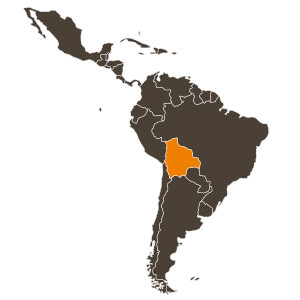Bolivia is a journey that cannot be explained with simple words, everything here is outsized proportions: the largest salt desert in the world, highest freshwater lake navigable of the world, highest international airport of the world, the 37 official languages ??recognized, larger silver heart in the 16th century in the world, excessive temperatures from hot to cold, Cordillera with peaks over 6000 meters, greatest blends of traditions and modernity, a colorful carnival in Oruro, the Huatia the oldest culinary dish of the Andes (18,000 years!), doctors with herbal prescriptions … How to not be appreciative face to a people who honor the earth, Pachamama, and believes in the sun, the moon, the earth and the mountains, while new technologies assail us? Broad discussion of the pros and cons … In any case, Bolivia, “Te quiero un Potosí!” And you too will love her immensely!

Bolivia program suggestions
Bolivia at a glance
- Area: 1,098,581 km². Roughly one and a half times the size of France.
- Population (approximately): 10 million 430 thousand inhabitants with the lowest density in Latin America.
- Constitutional capital: Sucre 350,000 inhabitants
Administrative capital: La Paz: 1 million 600 thousand inhabitants
The second largest city in the country: Santa Cruz de la Sierra: 1 million 800 thousand inhabitants
Economy: Main exports are natural gas, soybeans and its derivatives, oil, zinc and tin mining in Bolivia represents ¾ of exports. Bolivia has the second, behind Venezuela, natural gas reserves in South America. Untapped for now, the country would conceal half the world’s reserves of lithium (70% of reserves are located in the “triangle of lithium” three Andean salt flats).
Have read, seen and heard: (read) Los Andes no creen en Dios by Adolfo Costa Du Rels, novel later adapted to film by Antonio Eguino, the poet multi winner Javier del Granado or poems by Adela Azudio and Franz Tamayo, or the novels of Jaime Saenz with the backdrop of La Paz, (seen) the prowess of the mountain king Bernardo Guarachi, the first Bolivian to plant the Bolivian flag on the summit of Everest, (seen) the sculptures Miners in Revolt by the artist Marina Nuñez del Prado, (heard) the performance of Jaime Laredo’s violin and the folk rhythms of Enriqueta Ulloa, the charango of Ernesto Cavour and Potosi’s traditional air sung by Alvis Florindo. - To read, see and hear these days : (read) Cuentos de la Mina and El Laberinto del Pecado a social literature written by Victor Montoya, Amores Imperfectos and Rio Fugitivo by Edmundo Paz Soldan and American Visa by Juan Recacoechea or the history of Bolivia contemporary, novel adapted to the cinema, (see) Même la pluie by Iciar Bollain, whose action unfolds in a Bolivia torn by the conflict of water, (see) des documentaries from Andes to the Amazon Quand s’élèvent les voix de la Pachamama by Sylvie Brieu and sur la route du café des Yungas à la Bretagne by Bernard Bruel, (hear) baroque music from the album Fiesta Criolla under the direction of Gabriel Garrido and the orchestra Orquesta Experimental Instrumentos of Nativos under the baton of Cergio Prudencio.
